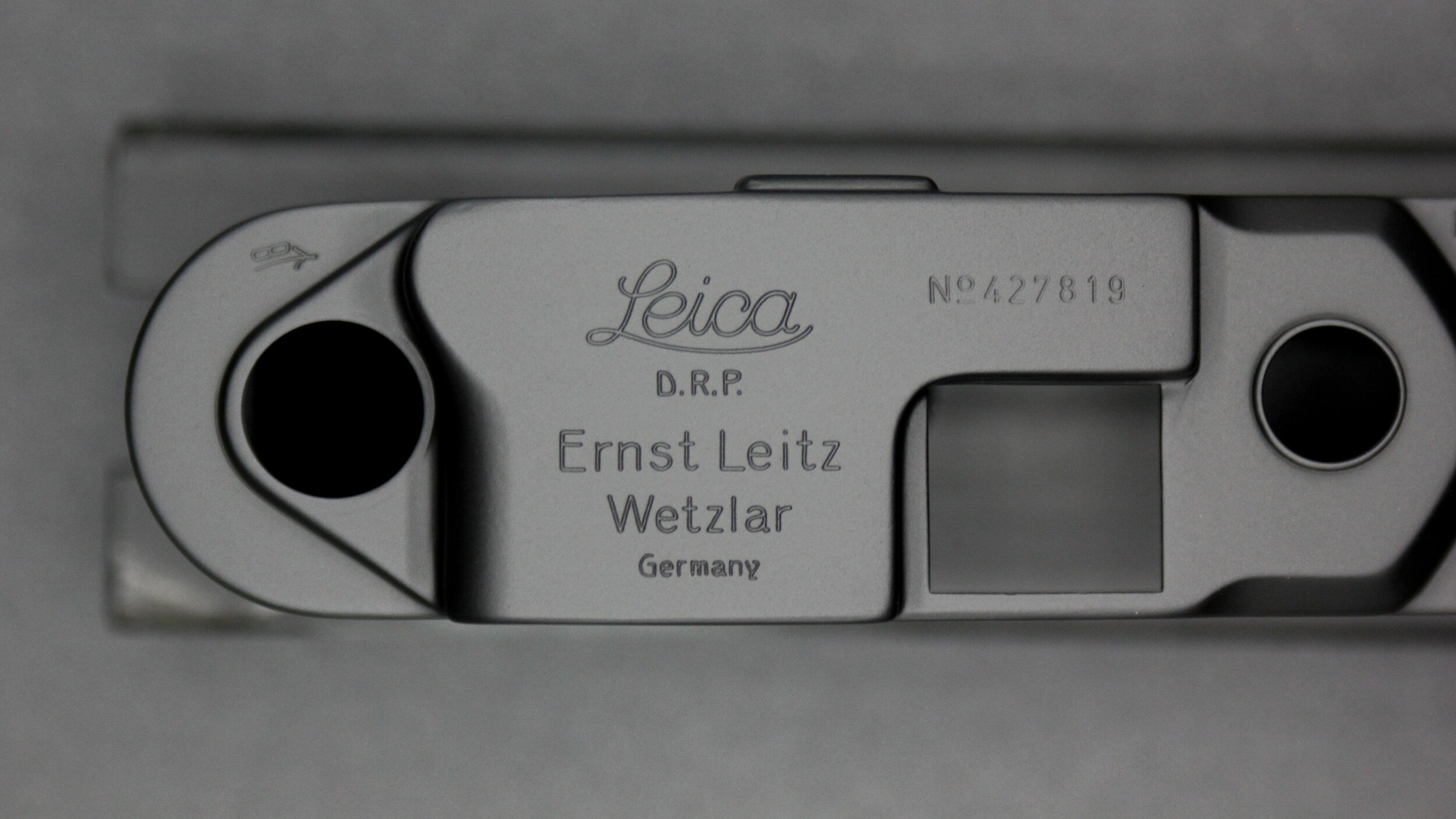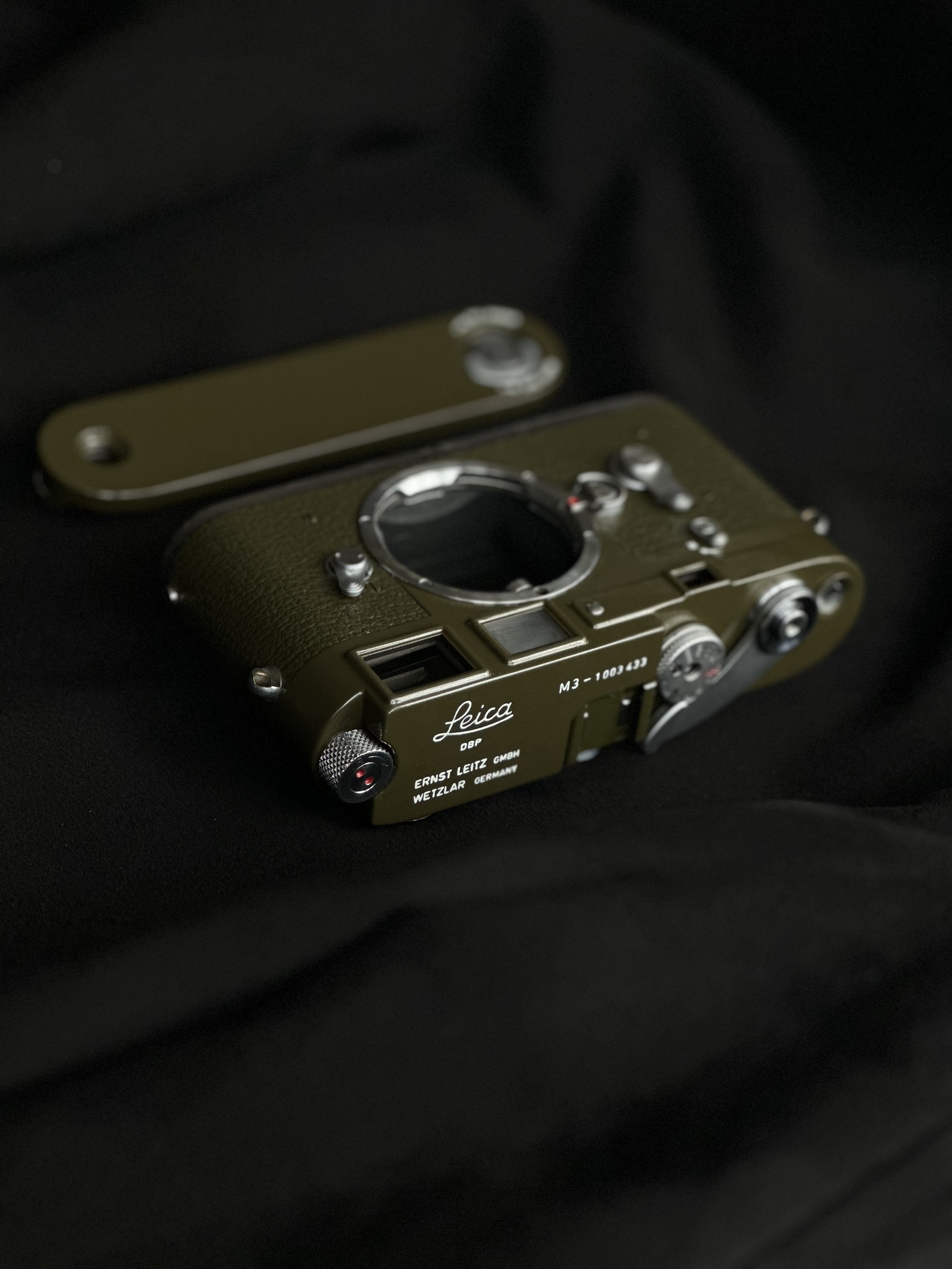
We can create myriad finishes for your Leica, from subtle elegance to vibrant imaginings
-
Condition
You may wish to refresh the appearance of your gear. We strive for a reconditioned surface that is consistent with your equipment’s original form.

-
Customise
Customisation offers complete autonomy for personalisation of your equipment. Colour combinations and finishes are yours to decide.

★★★★★
”The finish is, NGL, exquisite. All the inlay work is beautiful.”
-Timothy.P, Wiltshire (Leica IIIc, customised in Stealth Black)
★★★★★
”Aesthetically [my newly customised M3] is amazing. I love it.”
-Rodney.T, Los Angeles (Leica M3, customised in Stealth Black)
CONDITION
PITTING, DENTS, GRAZES
Undesirables such as pitting or dents can usually be mitigated or eliminated. We use a combination of metal working methods to fill, hand finish, and ameliorate dents.
CORROSION
The extent of the corrosion is categorised as either mild, moderate, or acute and a realistic assessment of the viability of reconditioning is made. Areas may have to be levelled to base metal prior to refinishing.
ZINC-PEST / ‘LEICA BUBBLES’
Zinc-pest or ‘Leica bubbles’ is caused by a malformation of base metal during the engineering process of early M6s. Information about zinc-pest can be found here. Apart from being an eyesore, zinc-pest can pose deeper issues that negatively impact your camera’s market value. If the bubbles rupture, exposed layers of unprotected metal are vulnerable to corrosion.
We assess the severity of as either mild, moderate, or acute. We then conclude the likely finish that can be achieved. In most cases, we can significantly improve the surface and stop the rot.
CUSTOMISE
Customisation overhauls can usually be completed within 8-10 weeks.
SUPPORTED CAMERA AND LENS SERIES
Leica Screw Mount Series
Leica M Series
Leica R Series
COATING TYPES
Cerakote OR Enamel-equivalent paint.
Cerakote yields an optimal aesthetic and practical performance required for showcases and real-world use alike. Cerakote can achieve a matt, satin, or high gloss finish.
Enamel-equivalent paints can yield a high-gloss traditional finish. They achieve a lustre finish that more easily develops a patina over time. We custom blend our own paints.
What exactly is Cerakote?
Cerakote produces the highest performing line of ceramic coatings available anywhere in the world. Cerakote is a hybrid formulation of ceramic and polymer. The properties of Cerakote when cured are surface hardness, flexibility on impact (no flaking), abrasion resistance, corrosion resistance, chemical resistance, thermal and UV colour stability.
How does the application of Cerakote differ from ‘normal’ paints?
Cerakote interlocks with the surface of a prepared substrate i.e. metal. This results in a coating that is resistant to damage and does not flake on impact. Cerakote yields an ultra fine, flat surface. This coating is the best for those who seek a chrome equivalent, or to replicate the original black paint finish used by Leica on the M2 and M3, and also for unusual colour patterns.
By comparison, enamel-equivalent paints are not as resistant to environmental damage. For instance, if knocked badly, the paintwork might chip or graze. They are similar to the types of coatings found on cars and aeroplanes. This coating is best for those who seek to replicate the glossy piano black finish used on models such as the Leica MP.
What about coach enamel?
We no longer offer coach enamel as standard, as the time taken for the paintwork to fully cure is 6-12 months, and varies highly depending on temperature, humidity, and airflow. Furthermore, coach enamel can be toxic to work with on a regular basis.
In summary, either coating has its merits, performance attributes, and styles; the choice of which to opt for is ultimately yours.
RESKIN
We have a wide selection of skins in different grain patterns available. The most popular type of skin we offer closely resembles the original leatherette pattern of the M2/M3. However, if you desire a particular grain pattern, we can match or acquire a suitable match that we can cut bespoke to fit your camera (but this will come at extra cost).
ENGRAVING FILLING
When we customise your camera, you have the option to choose replacement paint for the letter and number engraving sites on your equipment. We offer a wide selection of enamel or pastel-style paints in matt, satin, or gloss.
ACCESSORIES
We can also customise accessories such as lens caps or hoods for an additional cost.
COMBINED QUOTES
When assessing your equipment, we may also discover issues such as incorrect shutter speeds or lens haze; we can service your equipment at the same time as reconditioning and customisation for a discounted rate.
MULTI-COATED ANTI-REFLECTIVE
WINDOWS
WHAT ARE OUR ‘MULTI-COATED ANTI-REFLECTIVE WINDOWS’?
Our Multi-Coated (MC) Anti-Reflective (AR) Windows are bespoke, precision-cut windows made to replace the original and uncoated glass that sits in the outward-facing rangefinder and viewfinder window of legacy cameras. Leica first introduced coated optics to the M Series line in the M6 TTL, meaning that all legacy cameras prior to the TTL have uncoated windows.
WHAT ARE THE BENEFITS OF ANTI-REFLECTIVE COATINGS?
AR coatings are often used on prescription lenses or optical equipment in the science and medical industries. They can typically be identified if the coated object has a visible green or blue hue. AR coatings ‘block’ visible wavelengths and reduce glare from ambient light. When fitted into rangefinder top-plates in place of the original glass, our Multi-coated AR Windows reduce rangefinder glare/flare and increase viewfinder contrast for easier focusing. Our AR Windows are made from hardened borosilicate glass for high scratch resistance, keeping your windows clear for longer.
OTHER PERFORMANCE BENEFITS
We use glass that is manufactured by a specialist firm based in the Cambridge Science Cluster who supplies optics, R&D, medical, and engineering industries worldwide. Our AR Windows are made from borosilicate glass, known for its properties of supreme hardness, resistance to thermal shock, and scratch resistance. Borosilicate glass is used in scientific telescope optics, laboratory glassware, and lighting applications.
Fun fact: The Hale Telescope's 200 inch mirror is made of borosilicate glass.
Steps we take to achieve your desired finish
Assess
Each camera we receive is meticulously inspected and the owner receives an Inspection Report prior to being green-lit for reconditioning and/or customisation. This ensures full transparency.
Process
After dismantling your camera, selected parts are de-plated, re-surfaced, neutralised, media shot-blasted, and prepared as part of a workflow where attention to detail is
non-negotiable.
Proof
We hand-finish all components for reassembly. We test and ensure your camera meets required tolerances to ready it for years of use. From there, the camera is in your
good hands.









